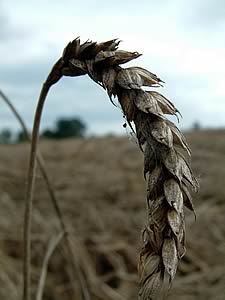30/09/08
Risks of mycotoxins in forages as well as feed grains are set to be unusually high this winter according to independent industry reports, increasing the necessity for greater vigilance and protective action by livestock farmers.
The wet harvest will undoubtedly mean more mouldy grain than usual.
 |
According to Alltech’s ruminant technical manager David Wilde, recent HGCA warnings of high fusarium mycotoxin development in cereal grains are mirrored by newly released information from Harper Adams University College that underlines the prevalence of some of the commonest mycotoxins in wholecrop and maize silages.
“This wet harvest will undoubtedly mean more mouldy grain than usual, and therefore a greater risk of mycotoxins in cereal-based feedstuffs, but forages can also be a source of the problem as the analyses carried out at Harper Adams illustrate,” he says.
“This work tested for the presence of four of the most common mycotoxins in random samples of wholecrop and forage maize taken during the relatively unhampered late summer harvesting period in 2007. Despite relatively good harvesting conditions, the results showed that these major mycotoxins are present in the majority of samples, commonly at high risk levels.
“Although mycotoxins are the products of mould metabolism, it is misleading to assume that an absence of visible mould means there is no risk. Moulds may be present in the growing crop pre-harvest or develop at any stage thereafter, and will produce mycotoxins often in response to some form of stress. This could be weather-related, or may be due to the ensiling process, but the important thing to remember is that mycotoxins may remain a risk long after any visible signs of mould have disappeared.”
The effects of mycotoxins are many and varied, but could include symptoms such as inconsistent milk yields, variable intakes, scouring, poor rumen function, swollen hocks or generally increased disease rates. Testing for mycotoxins is notoriously difficult, as they tend not to be evenly distributed in feed and analytical procedures only recognise a small proportion of the hundreds of known strains.
“My recommendation to farmers that have concerns is firstly to carry out a risk assessment,” adds David Wilde. “This will involve assessing the quality of feedstuffs, the storage environment and take into account factors such as harvesting conditions.
“If there is a tangible risk, I would recommend the addition of Mycosorb Farm Pak to the ration. Fed at 50g/cow/day, this will add 6-7p/cow/day to the cost of your ration, but will help to negate the effects of the vast majority of mycotoxins problems. This approach is being adopted routinely in parts of the world where mycotoxins are seen as ubiquitous in the feed, and I think this is a season when we should be reacting similarly.
“In a high challenge situation, or if symptoms are evident, an inclusion rate for Mycosorb Farm Pak of 100 – 150g/cow/day would be more appropriate.
For further information farmers are advised to log onto www.knowmycotoxins.com or contact Alltech on 01780 764512 for help with a risk assessment.
 Cultivate with Care to Avoid Further Soil Damage Cultivate with Care to Avoid Further Soil Damage
 Rampant Autumn Weed Growth Poses Major Threat Rampant Autumn Weed Growth Poses Major Threat
 Cabinet Secretary Sees Harvest Woes First Hand Cabinet Secretary Sees Harvest Woes First Hand
|



